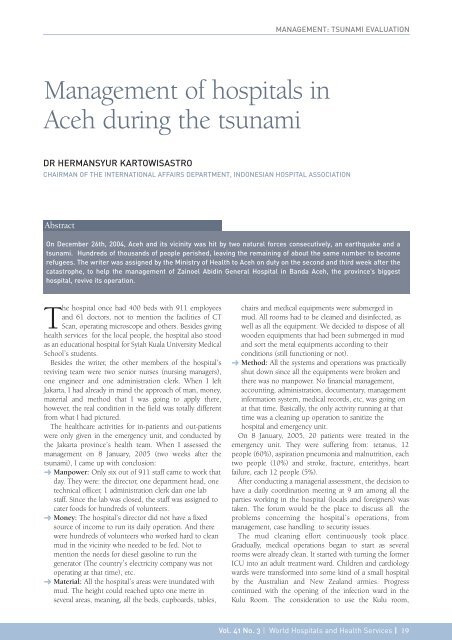World Hospitals and Health Services - International Hospital ...
World Hospitals and Health Services - International Hospital ...
World Hospitals and Health Services - International Hospital ...
You also want an ePaper? Increase the reach of your titles
YUMPU automatically turns print PDFs into web optimized ePapers that Google loves.
MANAGEMENT: TSUNAMI EVALUATION<br />
Management of hospitals in<br />
Aceh during the tsunami<br />
DR HERMANSYUR KARTOWISASTRO<br />
CHAIRMAN OF THE INTERNATIONAL AFFAIRS DEPARTMENT, INDONESIAN HOSPITAL ASSOCIATION<br />
Abstract<br />
On December 26th, 2004, Aceh <strong>and</strong> its vicinity was hit by two natural forces consecutively, an earthquake <strong>and</strong> a<br />
tsunami. Hundreds of thous<strong>and</strong>s of people perished, leaving the remaining of about the same number to become<br />
refugees. The writer was assigned by the Ministry of <strong>Health</strong> to Aceh on duty on the second <strong>and</strong> third week after the<br />
catastrophe, to help the management of Zainoel Abidin General <strong>Hospital</strong> in B<strong>and</strong>a Aceh, the province’s biggest<br />
hospital, revive its operation.<br />
The hospital once had 400 beds with 911 employees<br />
<strong>and</strong> 61 doctors, not to mention the facilities of CT<br />
Scan, operating microscope <strong>and</strong> others. Besides giving<br />
health services for the local people, the hospital also stood<br />
as an educational hospital for Syiah Kuala University Medical<br />
School’s students.<br />
Besides the writer, the other members of the hospital’s<br />
reviving team were two senior nurses (nursing managers),<br />
one engineer <strong>and</strong> one administration clerk. When I left<br />
Jakarta, I had already in mind the approach of man, money,<br />
material <strong>and</strong> method that I was going to apply there,<br />
however, the real condition in the field was totally different<br />
from what I had pictured.<br />
The healthcare activities for in-patients <strong>and</strong> out-patients<br />
were only given in the emergency unit, <strong>and</strong> conducted by<br />
the Jakarta province’s health team. When I assessed the<br />
management on 8 January, 2005 (two weeks after the<br />
tsunami), I came up with conclusion:<br />
➜ Manpower: Only six out of 911 staff came to work that<br />
day. They were: the director, one department head, one<br />
technical officer, 1 administration clerk dan one lab<br />
staff. Since the lab was closed, the staff was assigned to<br />
cater foods for hundreds of volunteers.<br />
➜ Money: The hospital’s director did not have a fixed<br />
source of income to run its daily operation. And there<br />
were hundreds of volunteers who worked hard to clean<br />
mud in the vicinity who needed to be fed. Not to<br />
mention the needs for diesel gasoline to run the<br />
generator (The country’s electricity company was not<br />
operating at that time), etc.<br />
➜ Material: All the hospital’s areas were inundated with<br />
mud. The height could reached upto one metre in<br />
several areas, meaning, all the beds, cupboards, tables,<br />
chairs <strong>and</strong> medical equipments were submerged in<br />
mud. All rooms had to be cleaned <strong>and</strong> disinfected, as<br />
well as all the equipment. We decided to dispose of all<br />
wooden equipments that had been submerged in mud<br />
<strong>and</strong> sort the metal equipments according to their<br />
conditions (still functioning or not).<br />
➜ Method: All the systems <strong>and</strong> operations was practically<br />
shut down since all the equipments were broken <strong>and</strong><br />
there was no manpower. No financial management,<br />
accounting, administration, documentary, management<br />
information system, medical records, etc, was going on<br />
at that time. Basically, the only activity running at that<br />
time was a cleaning up operation to sanitize the<br />
hospital <strong>and</strong> emergency unit.<br />
On 8 January, 2005, 20 patients were treated in the<br />
emergency unit. They were suffering from: tetanus, 12<br />
people (60%), aspiration pneumonia <strong>and</strong> malnutrition, each<br />
two people (10%) <strong>and</strong> stroke, fracture, enterithys, heart<br />
failure, each 12 people (5%).<br />
After conducting a managerial assessment, the decision to<br />
have a daily coordination meeting at 9 am among all the<br />
parties working in the hospital (locals <strong>and</strong> foreigners) was<br />
taken. The forum would be the place to discuss all the<br />
problems concerning the hospital’s operations, from<br />
management, case h<strong>and</strong>ling to security issues.<br />
The mud cleaning effort continuously took place.<br />
Gradually, medical operations began to start as several<br />
rooms were already clean. It started with turning the former<br />
ICU into an adult treatment ward. Children <strong>and</strong> cardiology<br />
wards were transformed into some kind of a small hospital<br />
by the Australian <strong>and</strong> New Zeal<strong>and</strong> armies. Progress<br />
continued with the opening of the infection ward in the<br />
Kulu Room. The consideration to use the Kulu room,<br />
Vol. 41 No. 3 | <strong>World</strong> <strong><strong>Hospital</strong>s</strong> <strong>and</strong> <strong>Health</strong> <strong>Services</strong> | 19

















